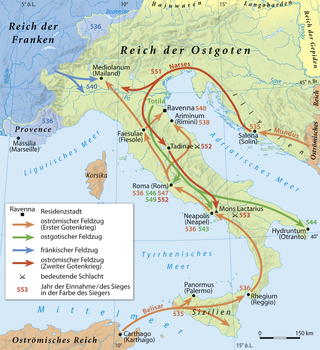
The Ostrogoths were a Roman-era Germanic people. In the 5th century, they followed the Visigoths in creating one of the two great Gothic kingdoms within the Western Roman Empire, drawing upon the large Gothic populations who had settled in the Balkans in the 4th century. While the Visigoths had formed under the leadership of Alaric I, the new Ostrogothic political entity which came to rule Italy was formed in the Balkans under Theodoric the Great.
The 530s decade ran from January 1, 530, to December 31, 539.
The 540s decade ran from January 1, 540, to December 31, 549.
The 550s decade ran from January 1, 550, to December 31, 559.
The 570s decade ran from January 1, 570, to December 31, 579.
The 580s decade ran from January 1, 580, to December 31, 589.

Year 554 (DLIV) was a common year starting on Thursday of the Julian calendar. The denomination 554 for this year has been used since the early medieval period, when the Anno Domini calendar era became the prevalent method in Europe for naming years.

Year 541 (DXLI) was a common year starting on Tuesday of the Julian calendar. In the Roman Empire, it was known as the Year of the Consulship of Basilius without colleague. Basilius was the last person to be officially appointed Roman consul, since after this year, the office was permanently merged with the office of Roman/Byzantine emperor. Thus, from the next year forward, the consular year dating was abandoned. The denomination 541 for this year has been used since the early medieval period, when the Anno Domini calendar era became the prevalent method in Europe for naming years.

Year 542 (DXLII) was a common year starting on Wednesday of the Julian calendar. From this year forward, the appointment of particular Roman consuls was abandoned and the office was merged with that of Byzantine emperor. Thus, the consular year dating was abandoned in practice, even though it formally remained until the end of the 9th century. The denomination 542 for this year has been used since the early medieval period, when the Anno Domini calendar era became the prevalent method in Europe for naming years.
Year 551 (DLI) was a common year starting on Sunday of the Julian calendar. The denomination 551 for this year has been used since the early medieval period, when the Anno Domini calendar era became the prevalent method in Europe for naming years.

Year 553 (DLIII) was a common year starting on Wednesday of the Julian calendar. The denomination 553 for this year has been used since the early medieval period, when the Anno Domini calendar era became the prevalent method in Europe for naming years.

Narses was, with Belisarius, one of the great generals in the service of the Byzantine Emperor Justinian I during the Roman reconquest that took place during Justinian's reign. Narses was a Romanized Armenian. He spent most of his life as an important eunuch in the palace of the emperors in Constantinople.

Totila, original name Baduila, was the penultimate King of the Ostrogoths, reigning from 541 to 552 AD. A skilled military and political leader, Totila reversed the tide of the Gothic War, recovering by 543 almost all the territories in Italy that the Eastern Roman Empire had captured from his Kingdom in 540.

At the Battle of Taginae in June/July 552, the forces of the Byzantine Empire under Narses broke the power of the Ostrogoths in Italy, and paved the way for the temporary Byzantine reconquest of the Italian Peninsula.

Teia, also known as Teja, Theia, Thila, Thela, and Teias, was the last Ostrogothic King of Italy. He led troops during the Battle of Busta Gallorum and had noncombatant Romans slaughtered in its aftermath. In late 552/early 553, he was killed during the Battle of Mons Lactarius. Archaeological records attesting to his rule show up in coinage found in former Transalpine Gaul.

The Battle of Mons Lactarius took place in 552 or 553 AD during the Gothic War waged on behalf of Justinian I against the Ostrogoths in Italy.

The Gothic War between the Byzantine Empire during the reign of Emperor Justinian I and the Ostrogothic Kingdom of Italy took place from 535 to 554 in the Italian peninsula, Dalmatia, Sardinia, Sicily, and Corsica. It was one of the last of the many Gothic wars against the Roman Empire. The war had its roots in the ambition of the Byzantine emperor Justinian I to recover the provinces of the former Western Roman Empire, which the Romans had lost to invading barbarian tribes in the previous century, during the Migration Period.

The city of Rome was besieged in AD 549–550 by the Ostrogoths, led by Totila, during a campaign to recapture Italy from the Byzantine Empire. After Totila imposed a blockade, soldiers from the city's garrison opened the gates to the Ostrogothic army. Many of Rome's male inhabitants were killed in the city or while attempting to flee—further reducing Rome's population which had collapsed in recent decades.

John, also known as John the Sanguinary, was the nephew of the rebel Vitalian and was an Eastern Roman general under Justinian I, who was active in the Gothic War in Italy and against the Gepids in the western Balkans. He was married to Justina, the daughter of Justinian's cousin Germanus.
Coccas was an Eastern Roman soldier who deserted to the Ostrogoths during the final stages of the Gothic War. Procopius calls him "a Roman soldier" and "a man of the Gothic army". His name is not Germanic, and might be Thracian.










